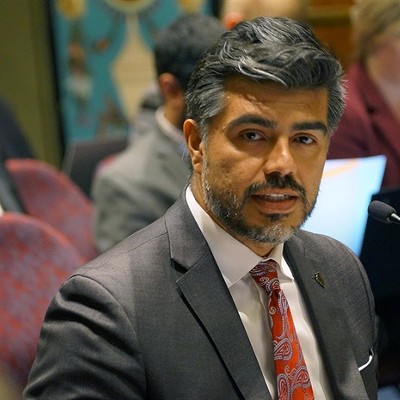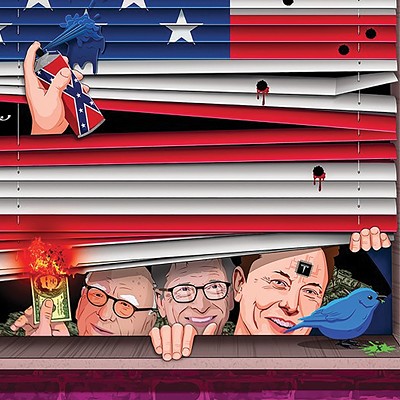Fake news is not a new thing. With the return of its annual list of censored stories Project Censored’s vivid cover art recalls H.G. Wells’ War of the Worlds. The situation today may feel as desolate as the cover art suggests.
“But Project Censored is about fighting fake news,” editors Andy Lee Roth and Mickey Huff observed.
In the end, they argued that “critical media education – rather than censorship, blacklists, privatized fact-checkers, or legislative bans – is the best weapon for fighting the ongoing fake news invasion.”
Project Censored’s annual list of censored stories is one of the best resources one can have for such education. Censorship and fake news are “intertwined issues” they write.
Project Censored has long been engaged in much more than just uncovering and publicizing stories kept down and out of the corporate media. Over the years it has added new analytical categories: sensationalist and titillating Junk Food News stories.
Through it all, the list of censored stories remains central to Project Censored’s mission, which, the editors point out, can be read in two different ways, “as a critique of the shortcomings of U.S. corporate news media for their failure to adequately cover these stories, or as a celebration of independent news media, without which we would remain either uninformed or misinformed about these crucial stories and issues.”
1. Global decline in rule of law as basic human rights diminish
According to the World Justice Project Rule of Law Index 2017-2018, released in January 2018, a striking worldwide decline in basic human rights has driven an overall decline in the rule of law since October 2016, the month before Trump’s election. Fundamental rights – one of eight categories measured – declined in 71 out of 113 nations surveyed. Overall, 34 percent of countries’ scores declined, while just 29 percent improved. The United States ranked 19th, down one from 2016, with declines in checks on government powers and deepening discrimination.
Fundamental rights include absence of discrimination, right to life and security, due process, freedom of expression and religion, right to privacy, freedom of association and labor rights.
“All signs point to a crisis not just for human rights, but for the human rights movement,” Yale professor of history and law Samuel Moyn told The Guardian the day the index was released. “Within many nations, these fundamental rights are falling prey to the backlash against a globalising economy in which the rich are winning. But human rights movements have not historically set out to name or shame inequality.”
This reflects the thesis of Moyn’s most recent book, Not Enough: Human Rights in an Unequal World.
Constraints on government powers, which measures the extent to which those who govern are bound by law, saw the second greatest declines (64 countries out of 113 dropped). This is where the United States saw the greatest deterioration, World Justice Project stated in a press release. “While all sub-factors in this dimension declined at least slightly from 2016, the score for lawful transition of power – based on responses to survey questions on confidence in national and local election processes and procedures – declined most markedly,” the press release stated.
“The WJP’s 2017–2018 Rule of Law Index received scant attention from US corporate media,” Project Censored noted.
2. “Open source” intelligence secrets sold to highest bidders
In March 2017, WikiLeaks released Vault 7, a trove of 8,761 leaked confidential CIA files about its global hacking programs, which WikiLeaks described as the “largest-ever publication of confidential documents on the agency.” It drew significant media attention. But almost no one noticed what George Eliason of OpEdNews pointed out.
“Sure, the CIA has all these tools available,” Eliason pointed out. “Yes, they are used on the public. The important part is [that] it’s not the CIA that’s using them. That’s the part that needs to frighten you.”
As Eliason went on to explain, the CIA’s mission prevents it from using the tools, especially on Americans.
“All the tools are unclassified, open-source, and can be used by anyone,” Eliason explained. “It makes them not exactly usable for secret agent work. That’s what makes it impossible for them to use Vault 7 tools directly.”
Drawing heavily on more than a decade of reporting by Tim Shorrock for Mother Jones and The Nation, Eliason’s OpEdNews series reported on the explosive growth of private contractors in the intelligence community, which allows the CIA and other agencies to gain access to intelligence gathered by methods they’re prohibited from using.
In a 2016, report for The Nation, Shorrock estimated that 80 percent of an estimated 58,000 private intelligence contractors worked for the five largest companies. He concluded that “not only has intelligence been privatized to an unimaginable degree, but an unprecedented consolidation of corporate power inside U.S. intelligence has left the country dangerously dependent on a handful of companies for its spying and surveillance needs.”
3. World’s richest one percent continue to become wealthier
In November 2017, Credit Suisse released its 8th Annual Global Wealth Report which The Guardian reported on under the headline, Richest 1% own half the world’s wealth, study finds.
The wealth share of the world’s richest people increased “from 42.5 percent at the height of the 2008 financial crisis to 50.1 percent in 2017,” The Guardian reported, adding that, “The biggest losers … are young people who should not expect to become as rich as their parents.”
“[Despite being more educated than their parents,] millennials are doing less well than their parents at the same age, especially in relation to income, home ownership and other dimensions of well-being assessed in this report,” Rohner Credit Suisse Chairman Urs Rohner said. “We expect only a minority of high achievers and those in high demand sectors such as technology or finance to effectively overcome the ‘millennial disadvantage.’”
“No other part of the wealth pyramid has been transformed as much since 2000 as the millionaire and ultra-high net worth individual (known as UHNWI) segments,” the report said. “The number of millionaires has increased by 170 percent, while the number of UHNWIs (individuals with net worth of USD 50 million or more) has risen five-fold, making them by far the fastest-growing group of wealth holders.”
There were of 2.3 million new dollar millionaires this year, taking the total to 36 million.
“At the other end of the spectrum, the world’s 3.5 billion poorest adults each have assets of less than $10,000,” The Guardian reported. “Collectively these people, who account for 70 percent of the world’s working age population, account for just 2.7 percent of global wealth.”
“Tremendous concentration of wealth and the extreme poverty that results from it are problems that affect everyone in the world, but wealth inequalities do not receive nearly as much attention as they should in the establishment press,” Project Censored noted. “The few corporate news reports that have addressed this issue – including an August 2017 Bloomberg article and a July 2016 report for CBS’s MoneyWatch – focused exclusively on wealth inequality within the United States. As Project Censored has previously reported, corporate news consistently covers the world’s billionaires while ignoring millions of humans who live in poverty.”
4. How Big Wireless convinced us cellphones and Wi-Fi are safe
Are cellphones and other wireless devices really as safe as we’ve been led to believe? Don’t bet on it, according to decades of buried research reviewed in a March 2018 investigation for The Nation by Mark Hertsgaard and Mark Dowie.
“The wireless industry not only made the same moral choices that the tobacco and fossil-fuel industries did, it also borrowed from the same public relations playbook those industries pioneered,” Hertsgaard and Dowie reported. “Like their tobacco and fossil-fuel brethren, wireless executives have chosen not to publicize what their own scientists have said about the risks of their products…. On the contrary, the industry – in America, Europe, and Asia – has spent untold millions of dollars in the past 25 years proclaiming that science is on its side, that the critics are quack, and that consumers have nothing to fear.”
Their report comes at the same time as several new developments are bringing the issue to the fore, including a Kaiser Permanente study (published December 2017 in Scientific Reports) finding much higher risks of miscarriage, and a study in the October 2017 American Journal of Epidemiology, finding increased risk for glioma (a type of brain tumor).
5. Washington Post bans employees from using social media to criticize sponsors
On May 1, 2017, the Washington Post introduced a policy prohibiting its employees from criticizing its advertisers and business partners, and encouraging them to snitch on one another.
“A new social-media policy at the Washington Post prohibits conduct on social media that ‘adversely affects the Post’s customers, advertisers, subscribers, vendors, suppliers or partners,” Andrew Beaujon reported in The Washingtonian the next month. “In such cases, Post management reserves the right to take disciplinary action ‘up to and including termination of employment.’” Beaujon also cited “A clause that encourages employees to snitch on one another: ‘If you have any reason to believe that an employee may be in violation of The Post’s Social Media Policy … you should contact The Post’s Human Resources Department.’”
At the time, the Washington-Baltimore News Guild, which represents the Post’s employees, was protesting the policy and was seeking removal of the controversial parts in a new labor agreement.
A followup report by Whitney Webb for MintPress News highlighted the broader possible censorship effects, as prohibiting social media criticism could spill over into reporting as well.
“Among the Washington Post’s advertisers are corporate giants like GlaxoSmithKline, Bank of America and Koch Industries,” Webb wrote. “With the new policy, social media posts criticizing GlaxoSmithKline’s habit of making false and misleading claims about its products, inflating prices and withholding crucial drug safety information from the government will no longer be made by Post employees.”
“Corporate news coverage of the Washington Post’s social media policy has been extremely limited,” Project Censored noted.
6. Russiagate: Two-headed monster of propaganda and censorship
Is Russiagate a censored story? Not exactly. This entry reflects a well-intentioned effort to critically examine fake news-related issues within a “censored story” framework. What Project Censored calls attention to is important: “Corporate media coverage of Russiagate has created a two-headed monster of propaganda and censorship. By saturating news coverage with a sensationalized narrative, Russiagate has superseded other important, newsworthy stories.” As a frustrated journalist with omnivorous interests, I heartily concur – but what’s involved is too complex to simply be labeled “propaganda.” On the other hand, the censorship of alternative journalistic voices is a classic, well-defined Project Censored story, which suffers from the attempt to fit both together.
In April 2017, Aaron Maté reported for The Intercept on a quantitative study of MSNBC’s “The Rachel Maddow Show” from Feb. 20 to March 31, 2017 which found that “Russia-focused segments accounted for 53 percent of these broadcasts.” Maté wrote:
“Maddow’s Russia coverage has dwarfed the time devoted to other top issues, including Trump’s escalating crackdown on undocumented immigrants (1.3 percent of coverage); Obamacare repeal (3.8 percent); the legal battle over Trump’s Muslim ban (5.6 percent), a surge of anti-GOP activism and town halls since Trump took office (5.8 percent), and Trump administration scandals and stumbles (11 percent).”
This is not so much propaganda as Project Censored’s broader category of “news abuse,” which includes propaganda and spin, among other forms of “distraction to direct our attention away from what we really need to know.”
7. Regenerative agriculture as “next stage” of civilization
The world’s agricultural and degraded soils have the capacity to recover 50 to 66 percent of the historic carbon loss to the atmosphere, according to a 2004 paper in Science, actually reversing the processes driving global warming. A set of practices known as “regenerative agriculture” could play a major role in accomplishing that, while substantially increasing crop yields as well, according to information compiled and published by Ronnie Cummins, director of the Organic Consumers Association in May 2017.
“For thousands of years we grew food by depleting soil carbon and, in the last hundred or so, the carbon in fossil fuel as well,” food and farming writer Michael Polin wrote. “But now we know how to grow even more food while at the same time returning carbon and fertility and water to the soil”
Cummins, who’s also a founding member of Regeneration International, wrote that regenerative agriculture offers a “world-changing paradigm” that can help solve many of today’s environmental and public health problems. As The Guardian explained:
“Regenerative agriculture comprises an array of techniques that rebuild soil and, in the process, sequester carbon. Typically, it uses cover crops and perennials so that bare soil is never exposed, and grazes animals in ways that mimic animals in nature. It also offers ecological benefits far beyond carbon storage: it stops soil erosion, re-mineralizes soil, protects the purity of groundwater and reduces damaging pesticide and fertilizer runoff.”
If you’ve never heard of it before, don’t be surprised.
“Regenerative agriculture has received limited attention in the establishment press, highlighted by only two recent, substantive reports in the New York Times Magazine and Salon,” Project Censored wrote.
8. Congress passes intrusive data-sharing law
On March 21, House Republicans released a 2,232-page omnibus spending bill. It passed both houses and was signed into law in two days. Attached to the spending provisions that made it urgent “must-pass” legislation was the completely unrelated Clarifying Lawful Overseas Use of Data Act of 2018, also known as the CLOUD Act.
“The CLOUD Act enables the U.S. government to acquire data across international borders regardless of other nations’ data privacy laws and without the need for warrants,” Project Censored summarized.
It also significantly weakens protections against foreign government actions.
“It was never reviewed or marked up by any committee in either the House or the Senate,” the Electronic Frontier Foundation’s David Ruiz wrote. “It never received a hearing…. It was robbed of a stand-alone floor vote because congressional leadership decided, behind closed doors, to attach this unvetted, unrelated data bill to the $1.3 trillion government spending bill.” Congressional leadership failed to listen to citizen concerns, Ruiz wrote, with devastating consequences:
“Because of this failure, U.S. and foreign police will have new mechanisms to seize data across the globe. Because of this failure, your private emails, your online chats, your Facebook, Google, Flickr photos, your Snapchat videos, your private lives online, your moments shared digitally between only those you trust, will be open to foreign law enforcement without a warrant and with few restrictions on using and sharing your information, privacy and human rights,” concluded Greene Robyn Greene, who reported for Just Security.
9. Indigenous communities helping to win legal rights of nature
In March 2017, the government of New Zealand ended a 140-year dispute with an indigenous Maori tribe by enacting a law that officially recognized the Whanganui River, which the tribe considers their ancestor, as a living entity with rights. The Guardian reported it as “a world-first,” although the surrounding Te Urewera National Park had been similarly recognized in a 2014 law, and the U.S. Supreme Court came within on vote of potentially recognizing such a right in the 1972 case Sierra Club v. Morton, expressed in a dissent by Justice William O. Douglas. In addition, the broader idea of ‘rights of nature’ has been adopted in Ecuador, Bolivia and by some American communities, noted Mihnea Tanasescu, writing for The Conversation.
The tribe’s perspective was explained to The Guardian by its lead negotiator, Gerrard Albert.
“We consider the river an ancestor and always have,” Albert said. “We have fought to find an approximation in law so that all others can understand that, from our perspective, treating the river as a living entity is the correct way to approach it, as an indivisible whole, instead of the traditional model for the last 100 years of treating it from a perspective of ownership and management.”
10. FBI racially profiling “black identity extremists”
At the same time that white supremacists were preparing for the “Unite the Right” demonstration in Charlottesville, which resulted in the murder of Heather Heyer in August 2017, the FBI’s counterterrorism division produced an intelligence assessment warning of a very different – though actually nonexistent threat: “black identity extremists.” The report appeared to be the first time the term had been used to identify a movement, according to Foreign Policy magazine, which broke the story.
“But former government officials and legal experts said no such movement exists, and some expressed concern that the term is part of a politically motivated effort to find an equivalent threat to white supremacists,” Foreign Policy reported.
“The use of terms like ‘black identity extremists’ is part of a longstanding FBI attempt to define a movement where none exists,” said former FBI agent Mike German, who now works for the Brennan Center for Justice. “Basically, it’s black people who scare them.”
Paul H. Rosenberg is senior editor at Random Lengths News, an alternative bi-weekly newspaper in the Los Angeles Harbor Area, where he previously served as managing editor.






















